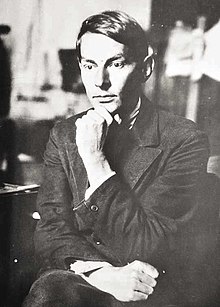Anatoly Alexandrov (physicist)
Anatoly Alexandrov | |
|---|---|
Анатолий Александров | |
Yuri Semenovich Lazurkin | |
| Website | A.P Alexandrov |
Anatoly Petrovich Alexandrov (Russian: Анатолий Петрович Александров, 13 February 1903 – 3 February 1994) was a Soviet physicist who played a crucial and centralizing role in the former Soviet program of nuclear weapons.
During his lifetime, Alexandrov was the recipient of many honors, civil citations, and state awards for this work and was also the director of the Kurchatov Institute and the President of the Soviet Academy of Sciences from 1975 until 1986.
Early life
Anatoly Alexandrov was born on 13 February 1903 into a Russian family of a prominent judge in the town of Tarashcha, Kiev Governorate, Russian Empire (now located in modern-day Ukraine).
In 1919, at the height of the
At the age of 16, he became a cadet and fought in the
Scientific career

Later he worked as an assistant at the Kiev Mining Institute as an electrician. He later worked as an electrical engineer at the Kiev Physicochemical Society under the Political Education and a high school teacher in the village of Belki, Kiev region. For several years, he combined his studies at the Physics and Mathematics Faculty of
After graduating from Faculty of Physics in Kiev University in 1930, he worked at the X-ray Physics Department in the
From the spring of 1931, he worked at the Leningrad Polytechnic Institute, where he became a candidate, and then a professor of physical and mathematical sciences.
World War II
Alexandrov became prominent during
Later career

Both Alexandrov and Kurchatov worked at the Ioffe Institute by that time (their laboratory separated from the Ioffe Institute and moved to Moscow in 1943 for the work on the Soviet atomic bomb project).[6]
From 1946 to 1955, he was director of the
Alexandrov was a member of the
In the 1960s, on the initiative of Alexandov, the largest helium liquefaction plant was built in the USSR . This provided a wide front for fundamental research in the physics of low temperatures, as well as on the technical use of superconductivity. He was the scientific supervisor of the project of RBMK reactor plants.[9]
Described by colleagues as a brilliant scientist and organizer, he was deeply affected by the Chernobyl disaster, the worst nuclear accident in history. According to him:
"To manage such an institute as the IAE, the largest institute and the most difficult work, and at the same time take care of the Academy - I must say, it was extremely difficult. In the end it ended sadly. And when the Chernobyl accident happened, I believe that from that time both my life began to end, and my creative life."
The accident subsequently prompted the
Alexandrov died of cardiac arrest on 3 February 1994 in Moscow. He is buried at the city's Mitinskoe Cemetery.
Personal life
Alexandrov was first married to Antonina Mikhailovna Zolotareva, with whom he had a son Yuri, a physicist. Antonina died in 1947. Alexandrov later remarried to Marianna Alexandrovna Balashov. They had a daughter Maria, who became a biologist, and two sons Peter and Alexander. Peter became a physicist and Alexander became a biologist. Marianna died in 1986.
His nephew is Eugene Alexandrov, a Russian physicist and member of the Russian Academy of Sciences (since 1992).
Honours and awards
- Army of Wrangel
| Cross of St. George, 2nd class | |
| Cross of St. George, 3rd class | |
| Cross of St. George, 4th class |
- Soviet Union
- Foreign
| Order of The People's Republic of Bulgaria, 1st class (Bulgaria) | |
Order of the Flag of the Republic of Hungary (Hungary )
| |
| Order of Sukhbaatar (Mongolia) | |
| Order of Merit of the Polish People's Republic, Commander with star (Poland) |
- Other awards
- Lenin Prize (1959)
- Stalin Prize (1942, 1949, 1951, 1953)
- Diploma of the Presidium of the Supreme Soviet of the Russian Federation (1993)
- Kurchatov Medal (1968)
- Lomonosov Gold Medal (1978)
- Vavilov Gold Medal (1978)
- XXXVIII Mendeleev Reader (4 February 1982)
References
- ^ "Академик Александров. За порядок и за сильную Россию". ruskline.ru. Retrieved 10 October 2020.
- ^ "Академик Александров. За порядок и за сильную Россию". ruskline.ru. Retrieved 10 October 2020.
- ^ "Академик Александров. За порядок и за сильную Россию". ruskline.ru. Retrieved 10 October 2020.
- ^ Johnson's Russia List.
- ^ "Академик Александров. За порядок и за сильную Россию". ruskline.ru. Retrieved 10 October 2020.
- ^ Alexandrov, A. P. (1983). "Годы с Курчатовым". Nauka i Zhizn (in Russian). No. 2.
- ^ Koptev, Y. I. (2008). Виза безопасности (in Russian). Saint Petersburg: Polytechnic University Press. p. 66.
- ^ Regel, V. P. (1975). "Размагничивание кораблей в годы Великой Отечественной войны". Priroda (in Russian). No. 4.
- ^ "Александров Анатолий Петрович". warheroes.ru. Retrieved 10 October 2020.
- ^ Dobbs, Michael (27 April 1992). "CHERNOBYL'S 'SHAMELESS LIES'". The Washington Post. Retrieved 15 November 2019.
External links
- "Academician A. P. Aleksandrov". Soviet Atomic Energy. 14 (3): 243–244. 1964. S2CID 189779885.
- "Russian Scientists – Johnson's Russia List 2-13-03". Archived from the original on 7 August 2009. Retrieved 29 March 2012.
